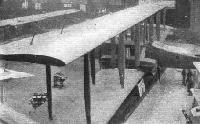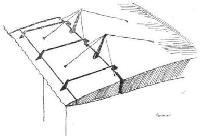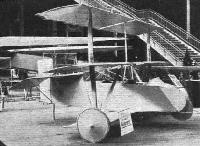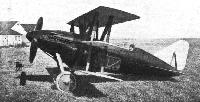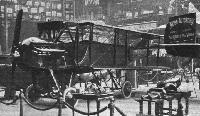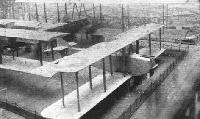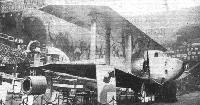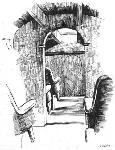Фотографии
-
THE "AD ASTRA" SILENCER: View of the apparatus fitted experimentally to a Siddeley "Puma" engine on a D.H.9 biplane.
Самолёты на фотографии: De Havilland D.H.9 - Великобритания - 1917
-
Регистрационный номер: H-NABA Fokkers at Paris: The N. V. Nederlandsche Vliegtuigenfabriek shows an "F.III" and a small glider of usual Fokker construction.
Самолёты на фотографии: Fokker E.V/D.VIII - Германия - 1918Fokker F.III - Нидерланды - 1921
-
The winner of the Pulitzer Race: The Curtiss-Navy Racer flown by Bert Acosta.
Самолёты на фотографии: Curtiss CR / R-6 - США - 1921
-
THE SECOND CZECH INTERNATIONAL AERO EXHIBITION AT PRAGUE: The "Avia" exhibits, that in the foreground being the B.H.3, a chaser monoplane fitted with a B.M.W. 185 h.p. engine; in the centre is a smaller edition for a 20 h.p. engine; the third machine is a sporting 2-seater with a 48 h.p. Gnome.
Самолёты на фотографии: Avia BH-1 - Чехословакия - 1920Avia BH-3 / BH-4 - Чехословакия - 1921
-
NIEUPORT-DELAGE MACHINE AT THE PARIS SHOW: The well-known type "29C1."
Самолёты на фотографии: Nieuport Nieuport-29 - Франция - 1918
-
FIRST FULL-SCALE EXPERIMENT WITH HANDLEY PAGE SLOTTED WING: The "D.H.9" fitted with slotted wings.
Самолёты на фотографии: Handley Page H.P.17 / H.P.20 - Великобритания - 1920
-
FIRST FULL-SCALE EXPERIMENT WITH HANDLEY PAGE SLOTTED WING: A close-up view of the arrangement of the slot.
Самолёты на фотографии: Handley Page H.P.17 / H.P.20 - Великобритания - 1920
-
CAUDRON AT THE PARIS SHOW: The old-timer used by Durafour for landing on Mont Blanc.
Самолёты на фотографии: Caudron G.3 - Франция - 1913
-
Регистрационный номер: F-FREF THE SECOND CZECH INTERNATIONAL AERO EXHIBITION AT PRAGUE: Bleriot-Spad Limousine, exhibited by the Compagnie Franco-Roumaine de Navigation Aerienne.
Самолёты на фотографии: Bleriot-SPAD S.33 / S.46 / S.50 / S.56 / S.66 - Франция - 1920
-
Mounting of "Jupiter" engine in Bristol "Badger" aeroplane.
Самолёты на фотографии: Bristol F.2C / Badger - Великобритания - 1919
-
CAUDRON AT THE PARIS SHOW: The type 60 used by Poiree
Самолёты на фотографии: Caudron C.27 / C.59 / C.60 - Франция - 1921
-
THE CAUDRON UNDERCARRIAGE: One side of the quickly-detachable undercarriage of the "C.59" and "C.60."
Самолёты на фотографии: Caudron C.27 / C.59 / C.60 - Франция - 1921
-
The Fokker "F.IV." - Three-quarter front view.
Самолёты на фотографии: Fokker F.IV / T-2 - Нидерланды - 1922
-
Fokker F.IV 380 H.P. Rolls Royce, 400 H.P. Liberty or 450 H.P. Napier Lion Engine
Самолёты на фотографии: Fokker F.IV / T-2 - Нидерланды - 1922
-
The Farman "Sport'' is this year shown fitted with an Anzani engine.
Самолёты на фотографии: Farman David / Sport - Франция - 1919
-
FARMAN AT THE SHOW: The huge four-engined night bomber.
Самолёты на фотографии: Farman BN.4 - Франция - 1921
-
The unusual arrangement of the aileron balance on the four-engined Farman.
Самолёты на фотографии: Farman BN.4 - Франция - 1921
-
SOME DETAILS OF THE FARMAN FOUR-ENGINED MACHINE: On the left, one of the engine nacelles. Note the steps which give access to the top plane fitting for folding the wings. On the right is shown one-half of the four-wheeled undercarriage.
Самолёты на фотографии: Farman BN.4 - Франция - 1921
-
The F.B.A. Flying Boat: Some details of the amphibian gear.
Самолёты на фотографии: FBA Type 16 / 17 - Франция - 1923
-
Регистрационный номер: G-EAXZ The Mars I as it appeared in the Martlesham tests: Note the clean lines, and the manner in which the Napier ''Lion'' has been cowled in. Also the fairings behind the wheels.
Самолёты на фотографии: Gloster Mars (Bamel) / Nighthawk / Sparrowhawk - Великобритания - 1921
-
The Hanriot School machine.
Самолёты на фотографии: Hanriot HD.14 / HD.17 / HD.41 - Франция - 1920
-
The Latecoere 8.
Самолёты на фотографии: Latecoere Late 8 - Франция - 1922
-
TWO LATECOERE DETAILS: On the left the very substantial tall skid, and on the right one side of an undercarriage.
Самолёты на фотографии: Latecoere Late 8 - Франция - 1922
-
THE SECOND CZECH INTERNATIONAL AERO EXHIBITION AT PRAGUE: The Military Aircraft Works 2-seater fighting "Sm.2" (260 h.p. Maybach).
Самолёты на фотографии: Letov S-1 / S-2 - Чехословакия - 1920
-
On the Pierre Levasseur Stand: On the left the skeleton of a torpedo 'plane, and on the right the side-by-side machine, which is of most unusual and rather clever design.
Самолёты на фотографии: Levasseur PL.1 - Франция - 1921Levasseur PL.2 - Франция - 1922
-
NIEUPORT-DELAGE MACHINE AT THE PARIS SHOW: The Coupe Deutsch monoplane flown by Kirsch.
Самолёты на фотографии: Nieuport-Delage Ni-D-41 / Sesquiplan - Франция - 1921
-
The Henry Potez type IX.
Самолёты на фотографии: Potez Potez IX - Франция - 1921
-
THE THOMAS-MORSE "M.B.-7" MONOPLANE: This machine was flown in the Pulitzer Race by Col. H. E. Hartney, who had engine trouble and crashed. A lighted match from souvenir hunters resulted in the machine being totally destroyed. Span, 24 ft.; chord, 5 ft. 6 ins.; overall length, 18 ft. 6 ins.; total wing area, 112 sq. ft.; weight loaded, 1,975 lbs.; weight/sq. ft., 17-6 lbs.; weight/h.p., 4-98 lbs.; engine, 320 b.p. Wright.
Самолёты на фотографии: Thomas-Morse MB-7 - США - 1921
-
Регистрационный номер: G-EATS Mounting of "Jupiter" engine in Bristol "Bullet" aeroplane.
Самолёты на фотографии: Bristol Bullet - Великобритания - 1919
-
On the Nieuport-Delage commercial machine ailerons are fitted to the top plane only. They are operated by cranks and struts from the lower plane.
Самолёты на фотографии: Nieuport Nieuport-30 - Франция - 1919
-
THE CLEMENT TRIPLANE GLIDER: This machine was shown in 1919 as a power-driven machine.
Самолёты на фотографии: Clement (Louis) triplane - Франция - 1919
-
THE RICCI "POPULAR" AEROPLANES: Details of the single-spar strut attachment.
Самолёты на фотографии: Ricci R.6 - Италия - 1920
-
The tail skid of the Ricci type R.6.
Самолёты на фотографии: Ricci R.6 - Италия - 1920
-
The Curtiss-Cox ("Cactus Kitten") Racer on which Coombs finished second in the Pulitzer Race.
Самолёты на фотографии: Curtiss Cox Racer (Cactus Kitten / Texas Wildcat) - США - 1920
-
THE SECOND CZECH INTERNATIONAL AERO EXHIBITION AT PRAGUE: Three "Aero" Aircraft Works exhibits - the " Ae.O.3 " (Hispano-Suiza), the " Ae.O.4 " (185 h.p. B.M.W.), and the " Ae.O.2 " (220 h p Hispano-Suiza).
Самолёты на фотографии: Aero Ae.02 / A.04 - Чехословакия - 1920
-
THE SECOND CZECH INTERNATIONAL AERO EXHIBITION AT PRAGUE: A close-up view of the "Ae.O.4."
Самолёты на фотографии: Aero Ae.02 / A.04 - Чехословакия - 1920
-
The Hanriot Coupe Deutsch Racer: This machine is built of metal throughout, except for the wing covering, which is of fabric.
Самолёты на фотографии: Hanriot HD.22 - Франция - 1921
-
The Hanriot Racer : View inside the cockpit, showing mounting of petrol tanks.
Самолёты на фотографии: Hanriot HD.22 - Франция - 1921
-
SOME DETAILS OF THE HANRIOT MONOPLANE RACER: The sketch on the left shows the mounting of the radiator above the fuselage. In the centre is part of the streamline undercarriage. The wheels have fabric discs doped on to cover all grooves, etc., except the tread of the tyre. The fin covering, shown on the right, is aluminium sheet, and is held on by turn-buttons.
Самолёты на фотографии: Hanriot HD.22 - Франция - 1921
-
The Tampier "Avion-Automobile" has a small auxiliary engine which drives it along the road at about 20 m.p.h., when the wings are folded and the rear wheels let down.
Самолёты на фотографии: Tampier T.1 - T.4 - Франция - 1921
-
The three-engined Caudron has the pilot's seat in front of the cabin.
Самолёты на фотографии: Caudron C.61 / C.81 / C.183 - Франция - 1921
-
THE CAUDRON UNDERCARRIAGE: One of the skid undercarriages of the "C.61." Note the arrangement for giving equal tension in the various rubber cords, and the skid below, which protects the rubber against wear.
Самолёты на фотографии: Caudron C.61 / C.81 / C.183 - Франция - 1921
-
One side of undercarriage of Potez X.A. Note the band brakes.
Самолёты на фотографии: Potez Potez X / XVIII / XXII - Франция - 1921
-
SOME POTEZ DETAILS: On the left, the attachment of a metal interplane strut. In the centre, one of the long pins by means of which the wings are attached to the centre-sections. On the right, the tail of the three-engined machine. Note the simple way in which the bracing of the auxiliary trimming plane and rudders are braced with two simple Vee struts.
Самолёты на фотографии: Potez Potez X / XVIII / XXII - Франция - 1921
-
Three-quarter front view of the Sanchez-Besa multiplane, 40 h.p. (British) A.B.C. engine.
Самолёты на фотографии: Sanchez-Besa multiplane - Франция - 1921
-
The Sanchez-Besa Multiplane: Designed in the form of a Venetian blind, the wing elements of this machine are of Duralumin sheet, with a filling of compressed cork.
Самолёты на фотографии: Sanchez-Besa multiplane - Франция - 1921
-
The undercarriage of the Sanchez-Besa multiplane is built up entirely of metal tubing.
Самолёты на фотографии: Sanchez-Besa multiplane - Франция - 1921
-
The sketch shows the construction of the small wing elements.
Самолёты на фотографии: Sanchez-Besa multiplane - Франция - 1921
-
FARMAN AT THE SHOW: The torpedo 'plane
Самолёты на фотографии: Farman Blanchard - Франция - 1921
-
THE PIERRE LEVASSEUR SPORTS MODEL: This machine is of most unusual design, the general scheme being indicated in the drawing.
Самолёты на фотографии: Levasseur PL.1 - Франция - 1921
-
Attachment, on the Pierre Levasseur, of the single tubular strut which runs from the undercarriage Vee to the rear portion of the fuselage.
Самолёты на фотографии: Levasseur PL.1 - Франция - 1921
-
THE SECOND CZECH INTERNATIONAL AERO EXHIBITION AT PRAGUE: The "Ardea" School monoplane (70 h.p. Mercedes).
Самолёты на фотографии: Prikryl-Blecha (Ardea) PB-1 - Чехословакия - 1921
-
The three-engined Latecoere is a very large machine for the number of passengers carried.
Самолёты на фотографии: Latecoere Late 4 - Франция - 1920
-
View inside the cabin of the Latecoere three-engined machine.
Самолёты на фотографии: Latecoere Late 4 - Франция - 1920
-
SOME LATECOERE DETAILS: The four-wheeled undercarriage of the three-engined machine. The shock absorbers are inside the wings.
Самолёты на фотографии: Latecoere Late 4 - Франция - 1920
-
THE LATECOERE L.A.T.6: This photograph of the fuselage was taken at the 1921 Paris Show, and shows the peculiar construction. The undercarriage has been entirely re-designed since then.
Самолёты на фотографии: Latecoere Late 6 - Франция - 1924
-
SOME LATECOERE DETAILS: The details of the crutch arrangement of the shock absorbers inside the wing root of the all-metal fuselage.
Самолёты на фотографии: Latecoere Late 6 - Франция - 1924
-
On the Liore et Olivier Stand: The "Leo 9" is an all-metal monoplane of the Junkers type. The wing section is the famous Schoukowsky aerofoil.
Самолёты на фотографии: Liore et Olivier LeO 9 - Франция - 1921
-
The Liore et Olivier monoplane is built of metal throughout. Sketch shows streamline casing over shock absorbers.
Самолёты на фотографии: Liore et Olivier LeO 9 - Франция - 1921
-
The Morane-Saulnier type "A.U." has cantilever wings of rather unusual design.
Самолёты на фотографии: Morane-Saulnier AU (MS-38) - Франция - 1921
-
The Morane-Saulnier cantilever monoplane is really intended as a full-scale experiment for a much larger machine, which is exhibited in model form on the M.S. stand. The sketch shows the wing bracing.
Самолёты на фотографии: Morane-Saulnier AU (MS-38) - Франция - 1921
-
The Dayton-Wright "F.P.2" Forest Patrol and Survey Seaplane. The machine is shown as fitted with two (420 h.p.) Liberty engines with tractor screws.
Самолёты на фотографии: Dayton-Wright FP-2 - США - 1921
-
The Dayton-Wright "F.P.2" Forest, Patrol and Survey Seaplane, as originally fitted with two (210 h.p.) Hall-Scott engines, and pusher screws.
Самолёты на фотографии: Dayton-Wright FP-2 - США - 1921
-
The Dayton-Wright "F.P.2" Forest, Patrol and Survey Seaplane. An interior view of the cabin.
Самолёты на фотографии: Dayton-Wright FP-2 - США - 1921
-
THE S.E.C.M.: Sketch showing wing bracing.
Самолёты на фотографии: SECM (Amiot) SECM 10 / 12 BN2 - Франция - 1921
Статьи
- Flight















